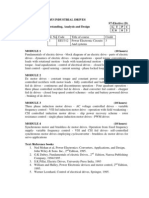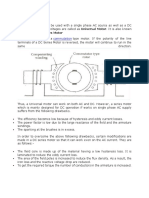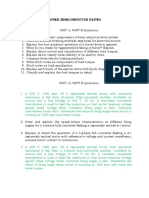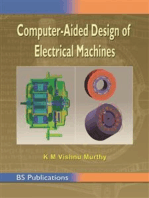0 ratings0% found this document useful (0 votes)
58 viewsSpeeed Control
Speeed Control
Uploaded by
Christine Gomez1. The document discusses several methods for controlling the speed of DC motors, including flux control, armature control, and voltage control.
2. For flux control, speed is adjusted by varying the field current through methods like adding resistance in the field winding or using a field diverter.
3. Armature control varies speed by adjusting the armature current through adding resistance in the armature circuit.
4. Voltage control directly varies the voltage applied to either the field or armature windings. The Ward-Leonard system provides especially smooth voltage control.
Copyright:
© All Rights Reserved
Available Formats
Download as DOCX, PDF, TXT or read online from Scribd
Speeed Control
Speeed Control
Uploaded by
Christine Gomez0 ratings0% found this document useful (0 votes)
58 views3 pages1. The document discusses several methods for controlling the speed of DC motors, including flux control, armature control, and voltage control.
2. For flux control, speed is adjusted by varying the field current through methods like adding resistance in the field winding or using a field diverter.
3. Armature control varies speed by adjusting the armature current through adding resistance in the armature circuit.
4. Voltage control directly varies the voltage applied to either the field or armature windings. The Ward-Leonard system provides especially smooth voltage control.
Original Description:
Original Title
speeed control.docx
Copyright
© © All Rights Reserved
Available Formats
DOCX, PDF, TXT or read online from Scribd
Share this document
Did you find this document useful?
Is this content inappropriate?
1. The document discusses several methods for controlling the speed of DC motors, including flux control, armature control, and voltage control.
2. For flux control, speed is adjusted by varying the field current through methods like adding resistance in the field winding or using a field diverter.
3. Armature control varies speed by adjusting the armature current through adding resistance in the armature circuit.
4. Voltage control directly varies the voltage applied to either the field or armature windings. The Ward-Leonard system provides especially smooth voltage control.
Copyright:
© All Rights Reserved
Available Formats
Download as DOCX, PDF, TXT or read online from Scribd
Download as docx, pdf, or txt
0 ratings0% found this document useful (0 votes)
58 views3 pagesSpeeed Control
Speeed Control
Uploaded by
Christine Gomez1. The document discusses several methods for controlling the speed of DC motors, including flux control, armature control, and voltage control.
2. For flux control, speed is adjusted by varying the field current through methods like adding resistance in the field winding or using a field diverter.
3. Armature control varies speed by adjusting the armature current through adding resistance in the armature circuit.
4. Voltage control directly varies the voltage applied to either the field or armature windings. The Ward-Leonard system provides especially smooth voltage control.
Copyright:
© All Rights Reserved
Available Formats
Download as DOCX, PDF, TXT or read online from Scribd
Download as docx, pdf, or txt
You are on page 1of 3
Gomez, Christine S
BSECE
Speed Control of Shunt Motor
1. Flux Control Method
It is already explained above that the speed of a dc motor is inversely
proportional to the flux per pole. Thus by decreasing the flux, speed can be increased
and vice versa. To control the flux, a rheostat is added in series with the field winding,
as shown in the circuit diagram. Adding more resistance in series with the field winding
will increase the speed as it decreases the flux. In shunt motors, as field current is
relatively very small, Ish2R loss is small. Therefore, this method is quite efficient. Though
speed can be increased above the rated value by reducing flux with this method, it puts
a limit to maximum speed as weakening of field flux beyond a limit will adversely affect
the commutation.
2. Armature Control Method
Speed of a dc motor is directly proportional to the back emf Eb and Eb = V -
IaRa. That means, when supply voltage V and the armature resistance R a are kept
constant, then the speed is directly proportional to armature current Ia. Thus, if we add
resistance in series with the armature, Ia decreases and, hence, the speed also
decreases. Greater the resistance in series with the armature, greater the decrease in
speed.
3. Voltage Control Method
a) Multiple voltage control:
In this method, the shunt field is connected to a fixed exciting voltage and armature is
supplied with different voltages. Voltage across armature is changed with the help of
suitable switchgear. The speed is approximately proportional to the voltage across the
armature.
b) Ward-Leonard System:
This system is used where very sensitive speed control of motor is required
(e.g electric excavators, elevators etc.). The arrangement of this system is as shown in
the figure at right. M2 is the motor to which speed control is required. M1 may be any AC
motor or DC motor with constant speed. G is a generator directly coupled to M1. In this
method, the output from generator G is fed to the armature of the motor M 2 whose
speed is to be controlled. The output voltage of generator G can be varied from zero to
its maximum value by means of its field regulator and, hence, the armature voltage of
the motor M2 is varied very smoothly.
Hence, very smooth speed control of the dc motor can be obtained by this
method.
Speed Control Of Series Motor
1. Flux Control Method
Field diverter: A variable resistance is connected parallel to the series field as
shown in fig (a). This variable resistor is called as a diverter, as the desired amount
of current can be diverted through this resistor and, hence, current through field
coil can be decreased. Thus, flux can be decreased to the desired amount and
speed can be increased.
Armature diverter: Diverter is connected across the armature as shown in fig (b).
For a given constant load torque, if armature current is reduced then the flux must
increase, as Ta ∝ Ø Ia. This will result in an increase in current taken from the
supply and hence flux Ø will increase and subsequently speed of the motor will
decrease.
Tapped field control: As shown in fig (c) field coil is tapped dividing number of
turns. Thus we can select different value of Ø by selecting different number of
turns.
Paralleling field coils: In this method, several speeds can be obtained by
regrouping coils as shown in fig (d).
2. Variable Resistance In Series With Armature
By introducing resistance in series with the armature, voltage across the
armature can be reduced. And, hence, speed reduces in proportion with it.
3. Series-Parallel Control
This system is widely used in electric traction, where two or more mechanically
coupled series motors are employed. For low speeds, the motors are connected in
series, and for higher speeds, the motors are connected in parallel.
When in series, the motors have the same current passing through them,
although voltage across each motor is divided. When in parallel, the voltage across
each motor is same although the current gets divided.
Speed control of separately excited DC motor
Speed of this type of dc shunt motor is controlled by the following methods:
I. Field control methods: Weakening of field causes increase in speed of the motor
while strengthening the field causes decreases the speed. Speed adjustment of this
type of motor is achieved from the following methods:
II. Field rheostat control: – Here a variable resistance is connected in series with the
field coil. Thus the speed is controlled by means of flux variation. Reluctance control
involving variation of reluctance of magnetic circuit of motor. Field voltage control by
varying the voltage at field circuit while keeping armature terminal voltage constant.
III. Armature control methods: Speed adjustment of separately excited DC motor by
armature control may be obtained by any one of the following methods :
i. Armature resistance control: – Here, the speed is controlled by varying the
source voltage to armature. Generally, a variable resistance is provided with
the armature to vary the armature resistance.
ii. ii. Armature terminal voltage control involving variation of variation of voltage
in armature circuit.
You might also like
- Electric BrakingDocument28 pagesElectric BrakingSabir BanvaNo ratings yet
- Modeling, Simulation, and Analysis of Permanent-Magnet Motor Drives, The Brushless DC Motor DriveDocument6 pagesModeling, Simulation, and Analysis of Permanent-Magnet Motor Drives, The Brushless DC Motor Drivekishan kharelNo ratings yet
- Custom Power DevicesDocument16 pagesCustom Power Devicessubhadip sadhukhanNo ratings yet
- Em 1 TestingDocument13 pagesEm 1 TestingAravindNo ratings yet
- Speed Control of DC MotorDocument31 pagesSpeed Control of DC Motorabhinav. alpheus651997No ratings yet
- How To Drive DC Motors With Smart Power IcsDocument14 pagesHow To Drive DC Motors With Smart Power IcsGoran ŽivkovićNo ratings yet
- Induction Motor DrivesDocument32 pagesInduction Motor DrivessidharthNo ratings yet
- Ssemd PPT1Document205 pagesSsemd PPT1control 4uonlyNo ratings yet
- EEE3100S 2023 Tutorials 6-7Document3 pagesEEE3100S 2023 Tutorials 6-7Stalin KosterNo ratings yet
- Ele3209 Assignment 2018Document1 pageEle3209 Assignment 2018aisha nakatoNo ratings yet
- Single Phasing and Phase UnbalanceDocument4 pagesSingle Phasing and Phase UnbalanceculwavesNo ratings yet
- DC Motor Speed ControllerDocument22 pagesDC Motor Speed ControllerShafqt MbrkNo ratings yet
- Eee-Vii-Industrial Drives and Applications (10ee74) - SolutionDocument54 pagesEee-Vii-Industrial Drives and Applications (10ee74) - SolutionAmit KumarNo ratings yet
- 3 Phase-Controlled DC Motor DrivesDocument45 pages3 Phase-Controlled DC Motor DrivesgilmartNo ratings yet
- EEE3100S 2023 Tutorial 6-7-MemoDocument6 pagesEEE3100S 2023 Tutorial 6-7-MemoStalin KosterNo ratings yet
- Transfer Function of A PMDC MotorDocument6 pagesTransfer Function of A PMDC MotorKenneth TanNo ratings yet
- Industrial DrivesDocument1 pageIndustrial DrivesSatish NurukurthiNo ratings yet
- Fly-Ball Governor: ReferenceDocument1 pageFly-Ball Governor: Referencenadya novarizkaNo ratings yet
- Machine Learning Applications-FDP-Updated SpeakerDocument5 pagesMachine Learning Applications-FDP-Updated SpeakerManojkumar VNo ratings yet
- Final Assignment EEE 111Document3 pagesFinal Assignment EEE 111Ahmed RakibNo ratings yet
- Universal Moto1Document12 pagesUniversal Moto1Saim MollahNo ratings yet
- 3 Point StarterDocument6 pages3 Point StartersuryavigneNo ratings yet
- Reduced Voltage Starting Using Part Winding Technique of 3-Phase Cage Rotor Induction MotorDocument8 pagesReduced Voltage Starting Using Part Winding Technique of 3-Phase Cage Rotor Induction MotorKennethNo ratings yet
- Tariffs and Load Curves (Module-2) : Presenter: Harshit Srivastava Aditya Srivastava Sparsh GuptaDocument24 pagesTariffs and Load Curves (Module-2) : Presenter: Harshit Srivastava Aditya Srivastava Sparsh GuptaAditya SrivastavaNo ratings yet
- Part - 3Document9 pagesPart - 3Keerthee MadhuriNo ratings yet
- Transformer FaultsDocument11 pagesTransformer FaultsMusembiNo ratings yet
- Single Phase AC Motor Speed Control Report With Altium FilesDocument27 pagesSingle Phase AC Motor Speed Control Report With Altium FilesHASEEB FAYYAZ ABBASI100% (1)
- Direct Torque Control of Induction MotorDocument37 pagesDirect Torque Control of Induction Motorpuria_rishabhNo ratings yet
- Static RelaysDocument11 pagesStatic RelaysBharathwaj SreedharNo ratings yet
- Assignment Induction MotorsDocument3 pagesAssignment Induction MotorsMallikarjunBhiradeNo ratings yet
- ECE 8830 - Electric Drives: Topic 16: Control of SPM Synchronous Motor DrivesDocument59 pagesECE 8830 - Electric Drives: Topic 16: Control of SPM Synchronous Motor DrivesHassan SouleymanNo ratings yet
- IDS NewDocument128 pagesIDS NewShahbaz Ali100% (1)
- Question Bank-EE2352 - Solid State DrivesDocument4 pagesQuestion Bank-EE2352 - Solid State Drivesdgsgovind100% (1)
- Unit 2 PDFDocument170 pagesUnit 2 PDFSaurabh RajNo ratings yet
- Drives Manual Final EeeDocument60 pagesDrives Manual Final EeenandhakumarmeNo ratings yet
- The 27-Level Multilevel Inverter For Solar PV ApplicationsDocument22 pagesThe 27-Level Multilevel Inverter For Solar PV ApplicationsAnand KumarNo ratings yet
- Variable Frequency Drive Navigation Search: From Wikipedia, The Free EncyclopediaDocument9 pagesVariable Frequency Drive Navigation Search: From Wikipedia, The Free EncyclopediaMadhar ShaNo ratings yet
- Design of The Rotor Blades of A Mini Hydraulic Bulb-TurbineDocument9 pagesDesign of The Rotor Blades of A Mini Hydraulic Bulb-TurbineuroskNo ratings yet
- Unit-Iv Rotor Side Controlled Induction Motor DriveDocument34 pagesUnit-Iv Rotor Side Controlled Induction Motor DriveChinnu ChinniNo ratings yet
- Power System Control and OperationDocument3 pagesPower System Control and OperationSantosh ThapaNo ratings yet
- Isolation and Protection of The Motor-Generator Pair System For Fault Ride-Through of Renewable Energy Generation SystemsDocument20 pagesIsolation and Protection of The Motor-Generator Pair System For Fault Ride-Through of Renewable Energy Generation SystemsUmesh GowdaNo ratings yet
- Digital Control Engineering Model Question PaperDocument5 pagesDigital Control Engineering Model Question PaperCyril Robinson Azariah JohnNo ratings yet
- Seminar Topic: Presented ByDocument11 pagesSeminar Topic: Presented ByAkash NiwalNo ratings yet
- Dynamic Braking and Plugging - Electrical ConceptsDocument3 pagesDynamic Braking and Plugging - Electrical ConceptsMohammad HamamdNo ratings yet
- Silicon Institute of Technology Department of Electrical & Electronics Engineering Quiz Test Electrical Machine-II Lab 5 Sem EEE-B, Gr.-I & IIDocument3 pagesSilicon Institute of Technology Department of Electrical & Electronics Engineering Quiz Test Electrical Machine-II Lab 5 Sem EEE-B, Gr.-I & IIT. VARMANo ratings yet
- Design and Analysis of A Dual Input DC-DC Converter For Hybrid Electric VehicleDocument23 pagesDesign and Analysis of A Dual Input DC-DC Converter For Hybrid Electric Vehiclejanga vishwanathNo ratings yet
- Part BDocument10 pagesPart BVenkat ManiNo ratings yet
- EE8411 - EM 2 LabDocument6 pagesEE8411 - EM 2 LabVengatNo ratings yet
- Evaluation of The Transient Response of A DC MotorDocument6 pagesEvaluation of The Transient Response of A DC MotorNesuh MalangNo ratings yet
- Bus Bar Differential Protection or Circulating Current ProtectionDocument2 pagesBus Bar Differential Protection or Circulating Current ProtectionsrifaceNo ratings yet
- Speed Control of MotorDocument5 pagesSpeed Control of MotorPrabuddha ChakrabortyNo ratings yet
- Electric Machines Lab: Open Ended Lab ReportDocument8 pagesElectric Machines Lab: Open Ended Lab ReportSaadNo ratings yet
- Speed Control of DC MotorsDocument27 pagesSpeed Control of DC MotorsBabuKannanNo ratings yet
- Speed Control of DC MotorsDocument2 pagesSpeed Control of DC Motorsmsd183wkNo ratings yet
- Speed Control Methods of DC MotorDocument6 pagesSpeed Control Methods of DC MotorMohd Izzat Abd GhaniNo ratings yet
- Santosh GuruDocument10 pagesSantosh Guru2108010eeNo ratings yet
- The Books Will Be Paired in Pairs "Sex Positions and Tantric Sex" and "Dirty Talk and BDSM". We Create Two SUBTITLE and Only Two DESCRIPTIONS! Template For Briefs For Ghost Writing CompaniesDocument28 pagesThe Books Will Be Paired in Pairs "Sex Positions and Tantric Sex" and "Dirty Talk and BDSM". We Create Two SUBTITLE and Only Two DESCRIPTIONS! Template For Briefs For Ghost Writing CompaniesChristine GomezNo ratings yet
- Agreement: Atty. Priscilla Elizel M. Pascua, R.NDocument1 pageAgreement: Atty. Priscilla Elizel M. Pascua, R.NChristine GomezNo ratings yet
- Menu Planning Share Cafe 1Document7 pagesMenu Planning Share Cafe 1Christine GomezNo ratings yet
- Case Study For Basic Theories As Frameworks in Ethics Art and OffenseDocument5 pagesCase Study For Basic Theories As Frameworks in Ethics Art and OffenseChristine GomezNo ratings yet
- Gomez For KantDocument2 pagesGomez For KantChristine GomezNo ratings yet
- Case Study GomezDocument2 pagesCase Study GomezChristine Gomez100% (2)
- Communication For Various PurposesDocument8 pagesCommunication For Various PurposesChristine GomezNo ratings yet
- Supply Chain Management: Gomez Camille Vegara Jay Ar John Paulo Riconalla Carmona Jea BSCM 2.2Document5 pagesSupply Chain Management: Gomez Camille Vegara Jay Ar John Paulo Riconalla Carmona Jea BSCM 2.2Christine GomezNo ratings yet
- MCTDocument9 pagesMCTChristine GomezNo ratings yet
- Math FomulasDocument13 pagesMath FomulasChristine GomezNo ratings yet
- Power MOSFET Rayen TineDocument7 pagesPower MOSFET Rayen TineChristine GomezNo ratings yet






































































